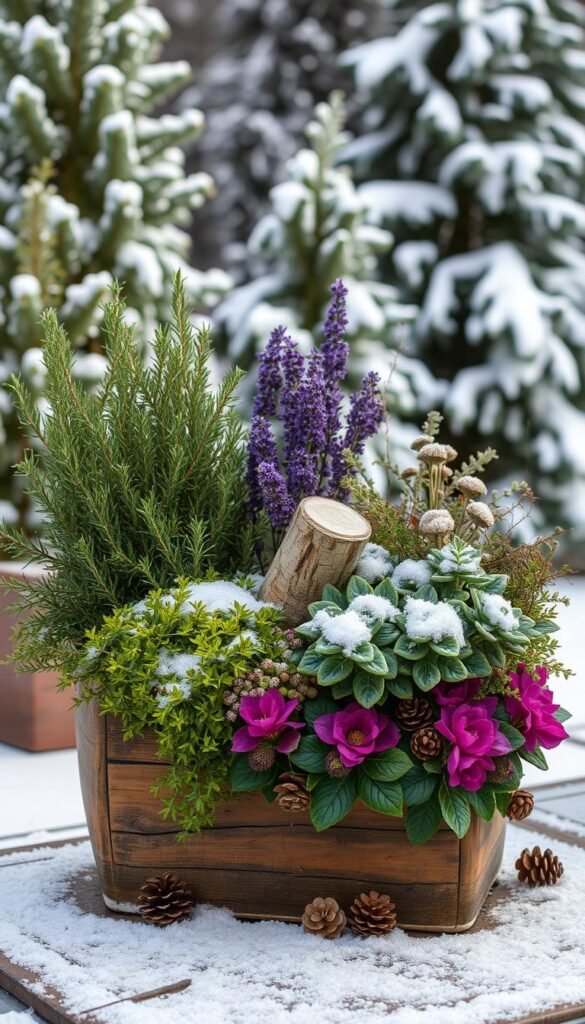Who says your outdoor space has to look bare once temperatures drop? With the right approach, you can create vibrant arrangements that thrive even when frost settles in. By focusing on resilient varieties and smart design, your pots and planters can become eye-catching focal points all year long.
This guide will help you pick species built to handle chilly conditions while adding texture and color to your setup. Think evergreens like ‘Wichita Blue’ juniper or compact shrubs such as Dwarf English Boxwood—these not only survive but shine in colder months. Pair them with decorative elements like birch branches or berry-filled stems for extra visual interest.
One major perk? You’ll save money by avoiding seasonal replanting. Containers also let you experiment with layouts without committing to permanent beds. Whether you’re sprucing up a patio or framing a front door, this method keeps your green thumb active—no matter the weather.
Key Takeaways
- Year-round beauty is achievable with frost-resistant varieties and thoughtful designs.
- Select species that naturally adapt to lower temperatures and limited sunlight.
- Combine textures and colors for dynamic displays that stand out in snow or rain.
- Reusable setups reduce long-term costs and maintenance efforts.
- Evergreens and dwarf shrubs offer structure, while seasonal accents add flair.
Introduction to Winter Container Gardening
Transform your outdoor space into a vibrant retreat even when the mercury dips. Many assume frosty weather means empty pots and barren displays, but that’s far from true. With strategic choices, you can craft lively arrangements that defy the chill.
Setting the Stage for Year-Round Greenery
Think of your pots as mini landscapes. Just like planning a backyard design, you’ll want layers of texture and color. Start with sturdy evergreens for structure—think dwarf shrubs or grasses with striking leaves. Add pops of burgundy or silver foliage for contrast.
This approach mimics permanent garden beds but offers flexibility. If a plant struggles, swap it without digging up your yard. According to This Old House, pairing conifers with trailing ivy creates dynamic cold-weather container designs that last for months.
Benefits of Cold-Hardy Plants in Containers
Why choose resilient varieties? They’re built to handle temperature swings and require less fuss. You’ll spend less time watering and more time enjoying:
- Sustained color: Red-twig dogwood stems or variegated holly leaves brighten gray days.
- Low upkeep: These plants adapt to limited sunlight and dry winter air.
- Easy transitions: Refresh pots in spring by simply adding seasonal blooms.
Whether you’re working with a balcony or sprawling patio, this method keeps your space lively through every season.
Why Embrace Winter Container Gardening?
Don’t pack away your pots just because the thermometer plunges. Frosty months offer a chance to craft striking outdoor displays that defy gloomy skies. Resilient varieties not only survive chilly conditions but evolve with character, developing richer hues and textures as temperatures fall.
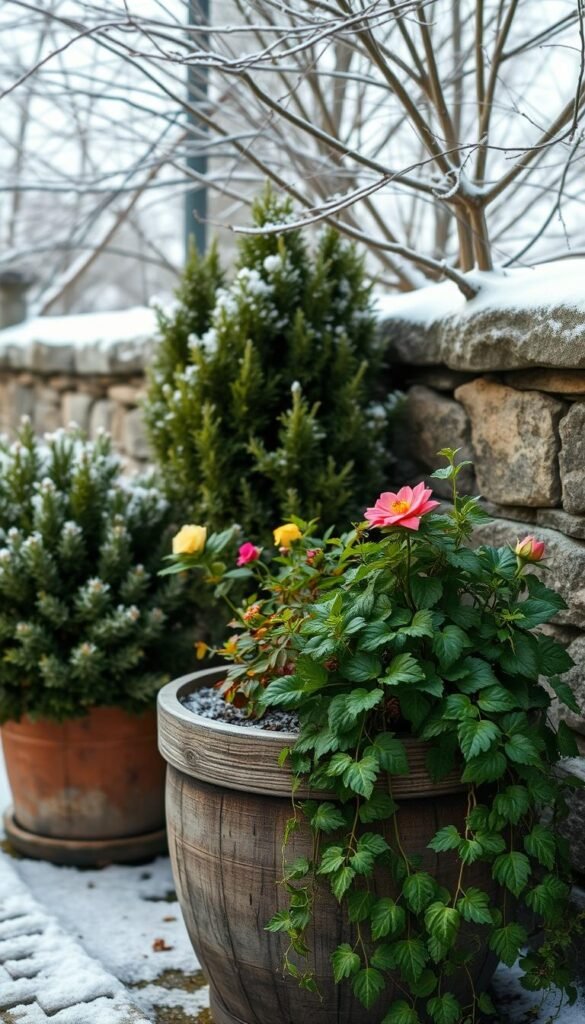
One major perk? Reusing the same planters year after year slashes costs. Swap out summer blooms for cold-tolerant picks like ornamental kale or heather—no need to buy new containers each season. You’ll also save time since these hardy selections require minimal watering once established.
Design freedom shines here. Play with bold contrasts: pair silvery dusty miller with crimson twig dogwood branches. “Winter arrangements thrive when you mix structure and seasonal flair,” notes Better Homes & Gardens. Evergreens anchor the look, while trailing ivy adds movement, creating visual drama even under snow.
Over time, these plantings mature into enduring focal points. Shrubs like dwarf juniper gain density, offering better wind protection and privacy with each passing year. Meanwhile, perennials like hellebores reward patience with early blooms when most gardens sleep.
Best of all, you’re not limited by frozen ground. Rearrange pots to catch fleeting sunlight or shield delicate roots near walls. With thoughtful choices, your outdoor space stays lively—proving beauty doesn’t hibernate.
Understanding Your USDA Hardiness Zone
Your garden’s success starts with a simple number: your USDA hardiness zone. These zones divide North America into regions based on average annual minimum temperatures. Knowing yours ensures you pick plants built to thrive in your local climate—especially when frost arrives.
Determining Your Zone
Finding your zone takes seconds. Visit the USDA’s official website and enter your zip code. Their interactive map color-codes regions from 1 (arctic cold) to 13 (tropical warmth). For example, Chicago falls in Zone 6a, where temps can dip to -10°F.
“This system removes guesswork,” explains a USDA horticulture specialist. Pair this data with your elevation and microclimates—like shaded patios or sun-trapped walls—for precision.
Adjusting Plant Choices Accordingly
Once you know your zone, match plants to their labeled tolerance. A Zone 5 shrub like ‘Green Mountain’ boxwood survives -20°F, while Zone 7-friendly camellias wilt below 0°F. Always check nursery tags or online descriptions for these ranges.
Stick to resilient picks for your area. In Zone 6, try hellebores or red-twig dogwood. Coastal Zone 9? Opt for wind-tolerant loropetalum. This alignment keeps roots healthy and reduces winter casualties.
Key Tips for Maintaining Winter Container Plants
Cold weather doesn’t mean your potted displays need to hibernate. With smart care routines, you can protect roots and foliage while keeping arrangements vibrant through frosty months. Let’s break down essential strategies for watering, feeding, and seasonal upkeep.
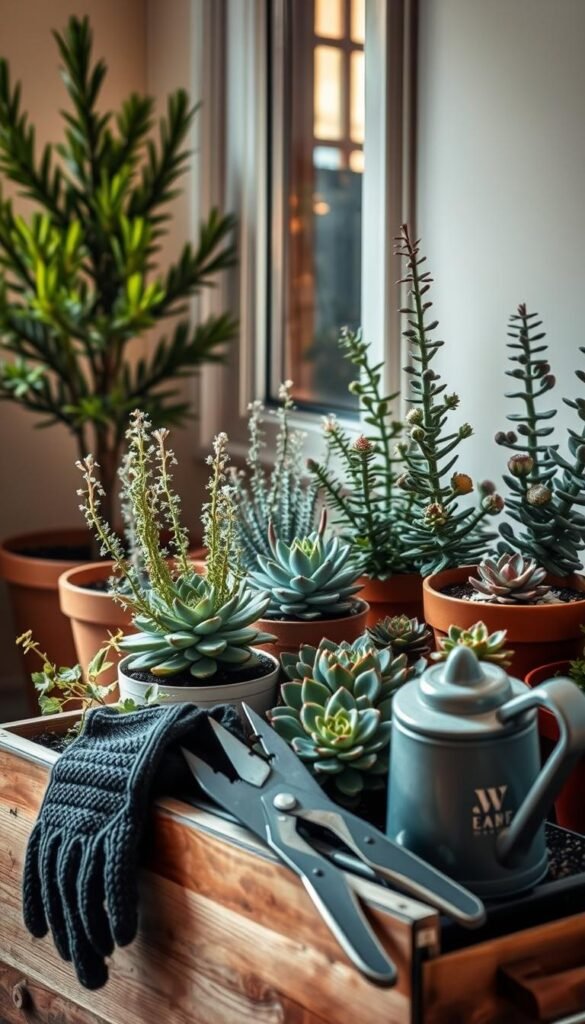
Smart Hydration and Nutrient Management
Water plants thoroughly before the ground freezes—moist soil insulates roots better than dry dirt. During warmer days above 40°F, check pots weekly. Pro tip: Water in the morning so excess moisture evaporates before nighttime freezes.
Stop fertilizing by late summer. New growth triggered by nutrients won’t survive sudden frosts. Instead, apply antidesiccant sprays to evergreen leaves. These coatings reduce moisture loss from harsh winds without blocking sunlight.
Pruning and Root Care Essentials
Trim dead branches in early winter to prevent disease, but avoid heavy pruning—it stimulates tender shoots. For overgrown plants, wait until late winter to repot. Use fresh, well-draining soil mixed with perlite to improve aeration.
| Task | Timing | Tools Needed |
|---|---|---|
| Deep Watering | Before first freeze | Watering can |
| Antidesiccant Spray | When temps drop below 50°F | Spray bottle |
| Light Pruning | Early December | Bypass shears |
Rotate pots occasionally to ensure even sun exposure. If you notice yellowing leaves, test soil pH—acidic conditions help many cold-tolerant species absorb nutrients. A little effort now means healthier plants come spring!
Essential Tools and Container Selection for Cold Climates
Selecting the right gear is half the battle when prepping for chilly months. Your pots need to withstand freeze-thaw cycles while protecting roots. Heavy plastic, stone, and fiberglass rank as top choices—they’re less likely to crack than terra cotta. Look for thick walls and rounded shapes that distribute pressure evenly.
Drainage holes are non-negotiable. Standing water turns into ice, which damages roots. Pair these with pot feet or gravel bases to elevate containers slightly. This prevents moisture buildup and improves airflow. For extra insulation, line pots with bubble wrap or burlap during deep freezes.
- Material pros:
- Fiberglass resists fading and weighs less than stone
- Recycled plastic retains heat better in zone 5-7 regions
Size matters more than you’d think. Too small, and soil dries out fast. Too large, and expanding frozen moisture can warp containers. Aim for pots 2-4 inches wider than root balls. Deeper designs help stabilize taller plants with heavy branches.
| Material | Best For | Example Products |
|---|---|---|
| Stone | Permanent displays | Campania International planters |
| Fiberglass | Frequent rearranging | Bloem Terra pots |
| Heavy Plastic | Budget-friendly setups | Keter Pacific resin planters |
Curved edges and wide bases prevent tipping in windy areas. Pair sturdy containers with trellises or stakes for vining plants. With these picks, your setup stays functional and eye-catching—no matter what the thermometer says.
Showcase of Cold-Hardy Evergreen Shrubs
Evergreen shrubs are the backbone of striking outdoor displays when other plants fade. Their year-round foliage provides structure while letting seasonal accents shine. Let’s explore two champions that thrive in confined spaces and frosty conditions.
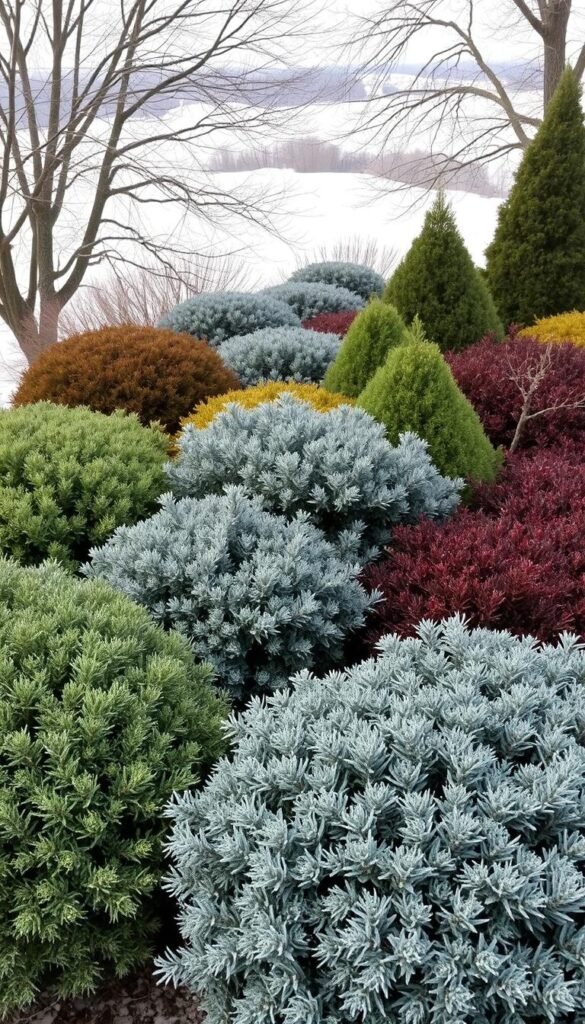
Dwarf Boxwoods: Neat & Adaptable
Compact varieties like ‘Green Velvet’ boxwood bring formal elegance to pots. Their slow growth (just 2-4 inches annually) means minimal pruning. Bonus: Their dense leaves block wind better than many flowering plants.
Arrange these near entryways or as symmetrical focal points. Pair with red twig dogwoods for fiery contrast against deep green foliage. University research shows boxwoods tolerate temps down to -20°F when properly mulched.
Junipers: Shape-Shifting Stars
From upright ‘Skyrocket’ to trailing ‘Blue Chip’, junipers adapt to any design role. Silver-blue varieties reflect sunlight beautifully, while golden types add warmth to gray days.
| Variety | Height | Design Role |
|---|---|---|
| Blue Star | 3 ft | Thriller |
| Lime Glow | 18″ | Filler |
| Bar Harbor | 6″ | Spiller |
These rugged performers handle drought and poor soil. “Their resinous sap naturally resists pests,” notes a Cornell horticulture report. Combine different textures—feathery juniper fronds beside glossy boxwood leaves create depth that snow accentuates.
Winter Container Gardening: Cold-Hardy Plants to Grow All Season
Gray skies don’t have to mean dull outdoor spaces. Strategic plant choices let you craft arrangements that pop against frosty backdrops. Mix textures and tones to turn pots into living art—even as days shorten.
Fall’s fading beauty can complement winter’s boldness. Add branches with lingering berries or seed pods for organic contrast. Pair these with evergreen foliage in deep greens or silvers. “The interplay between decay and vitality creates depth,” suggests Garden Design magazine.
Opt for varieties that shift hues in cooler weather. Ornamental kale develops richer purples after frost, while winter heather blooms in soft pinks. Red twig dogwood stems intensify to crimson, perfect for pairing with muted evergreens.
| Plant | Color Feature | Seasonal Transition |
|---|---|---|
| Ornamental Kale | Purple-veined leaves | Peaks in late fall, lasts through snow |
| Winter Heather | Pink/white blooms | Flowers December-February |
| Red Twig Dogwood | Vibrant stems | Brightens as temperatures drop |
Layer heights for drama. Place taller grasses behind low-growing heather, then trail ivy over pot edges. This “thriller-filler-spiller” approach works year-round but shines when frost highlights each element.
Your palette isn’t limited to greens. Yellow-toned sedum or blue spruce sprigs add unexpected vibrancy. With creativity, your arrangements become seasonal highlights rather than afterthoughts.
Designing Your Container with Thrillers, Fillers, and Spillers
Elevate your pot designs by borrowing a page from professional landscapers. The “thriller, filler, spiller” formula creates dynamic arrangements that catch the eye from every angle. Start with a bold centerpiece, then layer complementary plants to build depth and movement.
Choosing a Focal Point Plant (Thriller)
Your thriller sets the tone. Think vertical interest or striking foliage. A ‘Wichita Blue’ juniper adds icy-blue drama, while ornamental grasses like feather reed offer swaying texture. These anchors grow taller than their companions, demanding attention even in compact spaces.
Integrating Filler and Spiller Options
Fillers bridge the gap between your thriller and the pot’s edge. Try pansies for cheerful flowers or coral bells for ruffled leaves. Spillers soften edges—‘Calgary Carpet’ juniper trails gracefully, while creeping thyme spills over with fragrant greenery.
| Role | Examples | Key Feature |
|---|---|---|
| Thriller | ‘Wichita Blue’ Juniper | Vertical height |
| Filler | Pansies, Heuchera | Color saturation |
| Spiller | Creeping Jenny, Ivy | Trailing habit |
Balance is key. Place your thriller slightly off-center for asymmetry. Surround it with filler flowers in odd-numbered groups. Let spillers cascade freely—trimming them mid-season encourages bushier growth.
For year-round appeal, mix evergreen spillers like ivy with seasonal fillers like pansies. Their contrasting textures keep pots lively even when flowers fade. Rotate the pot monthly to ensure all sides get equal sunlight.
Enhancing Winter Color with Ornamental Kale and Winter Heather
Frosty mornings bring unexpected opportunities to play with color. Ornamental kale steals the show with its ruffled purple, pink, and ivory leaves that intensify in colder weather. These showy biennials thrive when others fade, offering painterly textures even under snow.
Pair kale with winter heather for delicate contrast. Heather’s tiny bell-shaped flowers bloom in shades of white, pink, and magenta from December onward. “They’re like confetti sprinkled over dreary days,” says a Seattle-based garden designer. Both plants handle light freezes but need protection during extreme cold snaps.
For best results:
- Water kale deeply before the ground freezes to prevent root dehydration
- Mulch heather with pine needles to maintain acidic soil conditions
- Position kale near container edges where its rosettes can fan out
| Plant | Sun Needs | Cold Tolerance |
|---|---|---|
| Ornamental Kale | Full sun | Down to 5°F |
| Winter Heather | Partial shade | Down to 0°F |
Elevate arrangements by layering heights. Place kale’s bold foliage at mid-level, then let heather’s low-growing stems spill forward. This combo works beautifully in shallow pots flanking doorways or lining walkways.
Don’t shy away from bold pairings! Try crimson kale against snow-dusted heather for holiday cheer. As temperatures fluctuate, these resilient performers adapt while keeping your space lively.
Foliage Fillers for Texture and Interest
Think of your planters as a canvas where every layer matters. Filler plants bridge bold centerpieces and trailing accents, creating harmony in limited spaces. Their leaves and textures soften harsh lines while adding depth that catches light and shadow.

Using Coral Bells and Bergenia Effectively
Coral bells (Heuchera) steal attention with ruffled leaves in plum, lime, or silver tones. These perennials thrive in partial sun and adapt to tight spots. Pair them with upright evergreens—their mounded shapes contrast beautifully with spiky grasses or conical shrubs.
Bergenia, nicknamed “pigsqueak” for its squeaky leaves, offers glossy foliage that turns burgundy in cooler weather. Its thick, rubbery texture stands up to wind, making it ideal for exposed balconies. Place these near pot edges where their broad leaves can spill slightly without overwhelming the design.
| Variety | Color Range | Light Needs |
|---|---|---|
| Heuchera ‘Palace Purple’ | Deep purple | Partial shade |
| Bergenia ‘Winterglut’ | Green to red | Full sun |
For dynamic arrangements, mix coral bells’ delicate veining with bergenia’s bold presence. “Texture contrast creates visual friction that holds interest,” notes a New York Botanical Garden designer. Alternate their placement around structural plants, using odd numbers for natural flow.
These fillers do more than look pretty—their dense growth helps retain soil moisture and suppress weeds. By choosing varied leaf sizes and sheens, you build displays that engage from every angle, proving function and beauty can coexist.
Flowering Options: Pansies and Violas for Seasonal Blooms
Brighten frosty days with pops of color that laugh at the cold. Pansies and violas deliver cheerful blooms when most flowers retreat, offering edible petals and extended performances. These cousins thrive in cool weather, with violas often outlasting pansies through temperature swings.
Tips to Maximize Color and Longevity
Start with healthy plants from local nurseries—look for compact growth and unopened buds. Give them at least 4 hours of sunlight daily. Morning sun helps dry dew quickly, reducing rot risks. Water when soil feels dry an inch below the surface, but avoid soggy roots.
Deadhead spent blooms weekly to encourage new flowers. Pro tip: Snip stems instead of pinching to prevent damage. As spring approaches, violas handle warming days better than pansies. Trim leggy growth in late winter to maintain bushy shapes.
| Plant | Bloom Period | Cold Tolerance |
|---|---|---|
| Pansies | Fall to Early Spring | Down to 15°F |
| Violas | October to May | Down to 5°F |
Both plants add edible flair to dishes. Toss pansy petals in salads or freeze them in ice cubes. Violas’ smaller flowers work beautifully as cake decorations. “Their mild, grassy flavor surprises guests,” shares a Colorado master gardener.
When spring arrives, let violas self-seed for next year’s display. Pansies may fade as heat builds, but their vibrant winter show makes them worth replanting annually. With simple care, these bloomers turn gray days into living rainbows.
Container Planting Techniques for Cold Weather Success
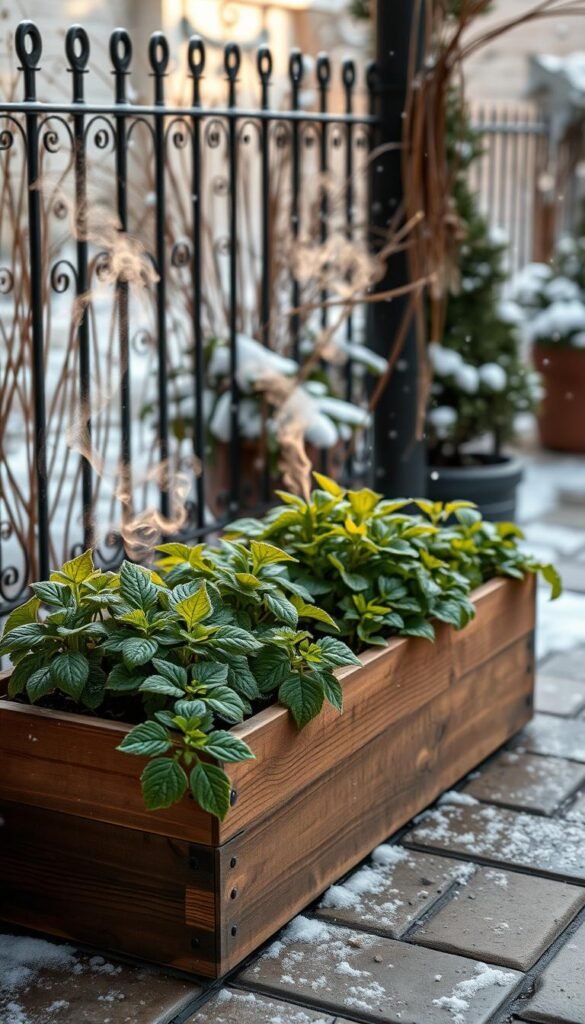
Frosty conditions demand clever strategies, not compromises, for thriving potted displays. Start by upgrading your soil mix—combine equal parts potting soil, perlite, and shredded bark. This trio improves drainage while creating air pockets that insulate roots from freeze-thaw cycles.
Elevate pots using wooden slats or specialized feet. Ground contact speeds up soil cooling, risking root damage. For extra protection, wrap containers in burlap or bubble wrap. Focus on the lower half where moisture accumulates.
Choose perennials with compact growth habits. Sedum ‘Autumn Joy’ and creeping phlox adapt well to confined spaces. Their shallow root systems handle temperature swings better than deep-rooted varieties. Pro tip: Leave 1-2 inches between soil surface and pot rim for mulch layers.
| Container Type | Benefits | Examples |
|---|---|---|
| Stone | Retains heat | Sedum, Sempervivum |
| Fiberglass | Lightweight insulation | Dianthus, Heuchera |
| Heavy Plastic | Moisture regulation | Bergenia, Coral Bells |
Refresh soil every 2-3 years for perennials staying in pots long-term. Early fall is ideal for repotting—roots establish before deep cold. Trim circling roots gently and add fresh compost to replenish nutrients.
Success comes from anticipating challenges. Group pots against south-facing walls for warmth. Use moisture meters to prevent overwatering. With these methods, your container plants become resilient showpieces that outlast icy spells.
Navigating the Seasonal Transition from Fall to Winter
As autumn’s fiery hues give way to crisp air, your plant care strategy needs a thoughtful pivot. Timing is everything—adjustments made now determine how well your arrangements weather the coming months.
Adapting Care Routines for Dropping Temperatures
Start by reducing watering frequency as daylight wanes. Deep soak roots once weekly until the ground freezes, then pause. This prevents ice buildup while keeping plants hydrated. Wrap delicate stems in burlap or use anti-desiccant sprays to shield leaves from drying winds.
Prune selectively in early fall. Remove dead branches to prevent disease but avoid heavy cuts that spur tender growth. Key tip: Complete repotting by late fall so roots establish before hard frosts. Use fresh soil with extra perlite for insulation.
| Fall Task | Winter Prep | Tools Needed |
|---|---|---|
| Trim spent foliage | Apply mulch layer | Bypass pruners |
| Check drainage | Install windbreaks | Soil moisture meter |
Rotate pots to expose all sides to sunlight as days shorten. If leaves yellow, test soil pH—many evergreens prefer slightly acidic conditions. These steps create a seamless shift, letting your displays thrive without missing a beat.
Creative Ideas for Decorative Winter Container Displays
Turn your outdoor space into a winter wonderland with imaginative touches that go beyond greenery. Elevate your arrangements by blending natural textures with playful accents—think beyond basic evergreens to create scenes that spark joy on gloomy days.
Incorporating Accessories and Natural Elements
Start with cedar boughs or curly willow branches for structure. These organic elements add height and drama while surviving frost. Weave in pinecones dipped in white paint for a snow-kissed effect, or nestle birch bark pieces between plants for rustic charm.
Festive accessories transform ordinary pots into showstoppers. Wrap battery-operated fairy lights around dogwood stems for a magical glow. Pro tip: Use waterproof ornaments as removable focal points—red berries or metallic stars pop against muted foliage.
| Natural Elements | Decorative Accents | Maintenance Tip |
|---|---|---|
| Cedar branches | Copper wire ribbons | Spray with antidesiccant |
| Dried hydrangeas | Glass icicle ornaments | Check weekly for moisture |
Quality pots make all the difference. Choose frost-proof materials like glazed ceramic—their smooth surfaces highlight colorful accents. Elevate containers on brick risers to improve drainage and showcase intricate designs.
Don’t shy away from bold contrasts. Pair silver-dusted juniper with crimson-painted magnolia pods. Repurpose summer planters by layering sphagnum moss over soil for a cozy, woodland vibe. With these tricks, your displays become conversation starters that shine through the coldest months.
User-Focused Tips for Outdoor Container Gardening in the US
Your pots can shine through every season with smart placement and protection. Where you position them matters as much as what you plant—especially when frost threatens. Let’s explore how to leverage your space for thriving displays that laugh at unpredictable weather.
Location and Shelter Considerations
In northern climates, tuck pots under covered porches or against south-facing walls. These spots block icy winds while trapping residual heat. Southern gardeners should prioritize afternoon shade to prevent soil from drying too fast.
Evergreen hedges make excellent natural windbreaks. Position beds near these green barriers to reduce exposure. For portable setups, use rolling plant caddies—they let you chase sunlight as days shorten.
| Region | Shelter Strategy | Container Size Tip |
|---|---|---|
| Northeast | Group pots near heated buildings | 12-18″ diameter |
| Midwest | Wrap with burlap screens | Deep pots for root insulation |
| Southwest | Morning sun, afternoon shade | Wider bases for stability |
Size matters in harsh climates. Smaller containers freeze faster—opt for 16″+ diameters in zone 6 or below. Add battery-powered string lights under frost cloths. They provide gentle warmth while highlighting your design after dark.
Water wisely: hydrate plants midday when temps rise above freezing. This prevents overnight ice damage. With these tweaks, your garden becomes a resilient showpiece that adapts to your local climate’s quirks.
Conclusion
Gardening enthusiasts know that frosty months offer a canvas for creativity. By choosing resilient varieties and thoughtful designs, your outdoor space stays lively even as days shorten. Evergreen shrubs provide structure, while pops of color from plants like dogwoods keep arrangements vibrant.
Patience pays off. Proper care ensures steady growth over years, turning small starts into lush displays. Those crimson stems you nurtured last fall? They’ll glow against snow, proving effort today brings beauty tomorrow.
Don’t hesitate to experiment. Mix textures—soft ivy trailing over stone pots, compact grasses adding height. Arrangements that rise a few feet tall create striking focal points, each reflecting your style while working with nature’s rhythm.
True, icy winds test limits. But with smart planning, your passion outlasts the chill. Whether it’s a balcony corner or sprawling patio, these living artworks thrive, reminding us that gardens don’t sleep—they adapt.

